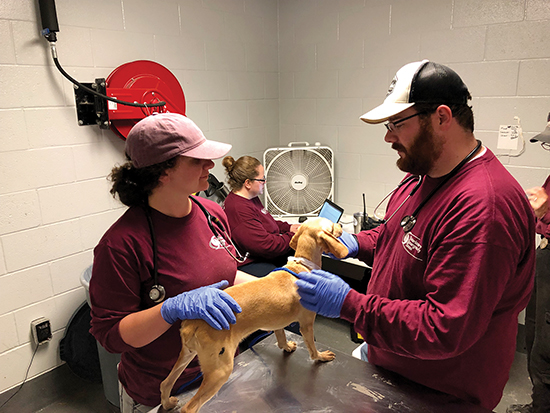National Preparedness Month
With September being National Preparedness month, it is important to not only prepare the people in our family for when disaster strikes, but also our pets as well. When creating a proper evacuation plan, we must remember to include the needs of our pets along with our own.

An important step in preparing for disasters is to have an evacuation kit for your family and your pets ready at all times.
Some things you may include in your pet’s evacuation kit would be plenty of food and water, any medication that your pets are on, their medical records and a picture of your pet. There is also a preparedness plan available on the Texas A&M College of Veterinary Medicine & Biomedical Sciences website that may be used as a guide to help you plan exactly what to bring.
“Depending on the disaster, families may be away from their homes from a few days to a few weeks,” said Dr. Deb Zoran, professor in the Department of Small Animal Clinical Sciences and Medical Operations Director for the Texas A&M Veterinary Emergency Team. “At a minimum, people should prepare to take at least three days worth of food from the pet’s current diet, water, and medications for their pets with them. Photos of the family with the pets and any veterinary records are important both for sheltering of the pet at an evacuation site as well as reunifying with pets when returning home.”
Along with proper medication and plenty of food and water, it is also a good idea to include blankets and other comforting items to put your pet at ease in the case of an emergency situation. Also include litter boxes for cats with litter, cleaning supplies and paper towels, and collars with their tags, or some other form of identification.
Pets can’t communicate the anxiety and fear they feel during a disaster, so it’s important to watch your pets for signs of anxiety in order to help calm them. When evacuating with your pets, have a secure carrier, leash, or harness to keep them from running off in panic.
“Small toys and appropriate sized carriers and crates may help to reduce the anxiety and stress that pets may feel during an evacuation,” said Zoran. “Adding these few items to a ‘go bag’ or ‘go box’ that you have ready to take in the event of an evacuation makes sure nothing important is left behind.”
The most important rule of thumb is never to leave your pets behind. They most likely will not be able to survive on their own, and it will be difficult to find them when you return. To make evacuating with your pet easier, checklists and informational brochures also may be found at http://www.ready.gov/caring-animals, or ask your local veterinarian for suggestions.
“The important thing to remember is if at all possible, take your pets with you if you have to evacuate,” said Zoran. “If it’s not possible, plan ahead and make arrangements to get them out of harm’s way. Taking a little bit of time in advance to create an appropriate plan for your family and your pets can save lives.”
Though an evacuation plan may seem unnecessary right now, you’ll be thankful that your family and pets are well prepared if disaster does strike.
Pet Talk is a service of the College of Veterinary Medicine & Biomedical Sciences, Texas A&M University. Stories can be viewed on the Web at vetmed.tamu.edu/news/pet-talk. Suggestions for future topics may be directed to editor@cvm.tamu.edu.


